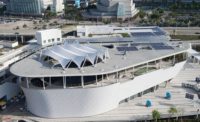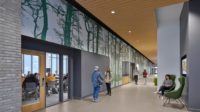Designed by PGAV Destinations in St. Louis, the new theater within the Kennedy Space Center Visitors Complex in Orlando engulfs visitors into the mystery of space travel with an extraordinary multi-media experience.
The theater is gateway to an incredible package of interactive experiences available within the Visitor Complex. Most notable is the opportunity to view the historic 90,000-square-foot Space Shute Atlantis attraction, which features the Atlantis Orbiter space shuttle, one of the most complex and sophisticated pieces of equipment ever made by man. Celebrating the major achievements of the U.S. space program, the Visitor Center offers an interactive education in the development of the International Space Station and the Hubble Space Telescope. The Visitors Complex is world renowned for its immersive experiences: A five-story IMAX theater, simulator rides, the world’s largest collection of personal astronaut memorabilia and even the opportunity to “have lunch” with an astronaut.
Unitized Panels Used to Create Drama
The unique configuration of the Visitor Complex theater immerses guests in a spectacular multimedia show. The architect designed a 28x28 projection screen—an expansion wide enough to wrap around a viewer’s peripheral vision—to create an immersive experience for guests visiting the space station. Arching over the entire room, the screen spreads over theatergoers as they stand to witness scenes of the famous Orbiter space shuttle in orbit, becoming part of the historic moment.
To bring the architectural drawings to life, the unitized panel manufacturer Radius Track and drywall contractor Wal-Mark Contracting Group LLC (a drywall subcontractor) partnered to fabricate four huge twisting arches that rise symmetrically above the theater. When the multi-media show starts on the big screen, images of a space shuttle dance over the arches, creating a multi-sensory effect of the images “leaping” off the screen to the arches. With careful attention to how sound plays off the arches and a special acoustic ceiling, the soundtrack engulfs the visitor with the ultimate “space travel” experience.
Craftsmanship Meets Engineering
A case study in engineering, this project displays expert craftsmanship in a situation where precision matters. Because there are minute nuances in the curvature of each square arch, the geometry had to be perfect.
|
THE EXHIBIT SPACE SHUTTLE ATLANTIS CAPE CANAVERAL, Fla. — At the Kennedy Space Center Visitor Complex in Florida, the spacecraft will be the centerpiece of a 90,000-square-foot building in which visitors will see Atlantis as it appeared in space. The payload bay doors are opened and the shuttle's Canadarm remote manipulator system — its robotic arm — installed and extended. The new $100 million facility includes interactive exhibits that tell the story of the 30-year Space Shuttle Program and highlight the future of space exploration. |
Due to the massive size of the arches, Radius Track responded with a unitized panel solution: by using sophisticated modeling technology, the arches were designed using 11 panels and a keystone panel as a center point. The panels are designed to “index” into each other using hooks, so that each panel does not need to be hung independently. Wal-Mark Contracting suspended the keystone panels to the ceiling and then added panels to the arches all the way to the floor, like giant connecting Lego blocks. Because the room is shaped like a trapezoid, the changing geometry had to be considered at every step.
The arches also serve as a hiding place for projection cameras, A/C vents and other equipment for the 250-person theater. To ensure seamless construction, the entire multi-media team worked off the final models.
Designing from a Distance
Another challenge of this project is that the design and construction took place in two different cities. To ensure each panel was precise, Radius Track designed custom equipment to hold each panel from its workspace in Minneapolis. The building teams received intricate, color-coded and detailed instructions when the panels were being assembled onsite at Kennedy Space Center in Orlando. Such attention to detail sped along the efficiency and accuracy during construction.
Radius Track assisted from the start in determining material take-offs and offering economic engineering concept options. On this project, the economic engineering concept was developed electronically. The company used its 3-D modeling and clash detection capabilities to identify possible conflicts to be resolved in the shop drawing phase to avoid job site delays or costly change orders. With the arches serving as both movie screens and housing for acoustic and lighting elements, this step was significant in terms of cost savings. The structural applications that arrived at the site were fabricated according to signed and sealed structural drawings and calculations. Every unitized panel was clearly marked, loaded on the truck in the order they would be needed and the accompanying drawings showed the proper sequence of assembly for quick and easy installation at the job site.
“We’d never done anything like this before, so the level of detailed instructions helped enormously. From our standpoint, building the arches was the easiest part of the project because the process was so well thought out in advance,” says Dan Whited, project manager at Wal-Mark Contracting.









Report Abusive Comment